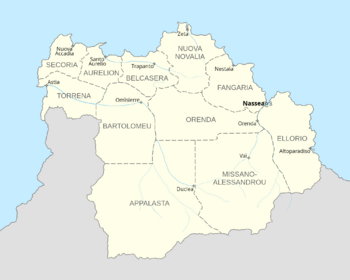Gapolania: Difference between revisions
mNo edit summary |
|||
| Line 158: | Line 158: | ||
{| class="wikitable sortable" | {| class="wikitable sortable" | ||
!Name !!Type !!Capital !!Area !!Population | !Name !!Type !!Capital !!Area (km<sup>2</sup>) !!Population | ||
|- | |- | ||
|[[File:Governorate_Appalasta_flag.png|25px]] Appalasta ||Governorate ||Duclea ||153,087 ||1,244,095 | |[[File:Governorate_Appalasta_flag.png|25px]] Appalasta ||Governorate ||Duclea ||153,087 ||1,244,095 | ||
Revision as of 12:37, 9 December 2020
This article is incomplete because it is pending further input from participants, or it is a work-in-progress by one author. Please comment on this article's talk page to share your input, comments and questions. Note: To contribute to this article, you may need to seek help from the author(s) of this page. |
Republic of Gapolania Repubblica Gapolanesa Gapolanijska Republika | |
|---|---|
Motto: Uniti per sempre United forever | |
Anthem: Le braci dei nostri cuori Royal anthem: Our heart's embers | |
 Location of Gapolania in Kylaris | |
 Administrative map of Gapolania | |
| Capital and | Nassea |
| Official languages | Vespasian Novalian |
| Recognised regional languages | Jimoka |
| Ethnic groups (2018) |
|
| Religion (2018) |
|
| Demonym(s) | Gapolanese |
| Government | Constitutional parliamentary unitary republic |
| Mosè Maggiacomo | |
• Prime Minister | Ivano Cerbone |
| Legislature | Senate |
| Independence from | |
• Declared | 18th October, 1810 |
| 24th April, 1915 | |
• Current constitution | 12th January, 1934 |
| Area | |
• Total | 634,224 km2 (244,875 sq mi) |
| Population | |
• 2018 census | |
• Density | 30.9/km2 (80.0/sq mi) |
| GDP (PPP) | 2019 estimate |
• Total | |
• Per capita | |
| GDP (nominal) | 2019 estimate |
• Total | |
• Per capita | |
| Gini (2019) | 39.6 medium |
| HDI (2019) | 0.818 very high |
| Currency | Gapolanese Moneta (GPM) |
| Time zone | UTC+15 (Western Lumine Time) |
| Date format | dd.mm.yyyy |
| Driving side | right |
| Internet TLD | .gp |
| |
Gapolania, officially Republic of Gapolania (Vespasian: Repubblica Gapolanesa; Novalian: Gapolanijska Republika)) is a sovereign country in Asteria Inferior. It borders Caluchia to the south-west, while bordering the East Arucian Sea to the north-west and the Lumine Ocean to the north and east. The country is a parliamentary unitary republic, divided into 11 governorates (governatorato, namjesništvo) and a capital domain of Nassea, which is also the republic's most populated city.
Povelian settlers first arrived in the region during early 16th century, establishing a port town of Nassea. This was followed by mass Vespasian migration and spread of Catholicism in the newly established state. Following the establishment of First Etrurian Republic, republican ideas spread to Gapolania and, upon restoration of monarchy in the metropolis, the country declared its independence in 1810, being the last Etrurian colony in Asterias to do so. The republic saw large influx of Vespasian and, particularly, Novalian immigrants in the second half of 19th century, resulting in rapid economic development, based on principles of industrial revolution that took place in Euclea. Rising tensions between Vespasian and Novalian immigrants, as well as a worldwide economic crisis, resulted in a far-right movements coming to power. In 1915, Lorenzo Castiglione established "Regime of the Sun" (Soleggiato), focused mostly on economic development through investments in heavy industry, discrimination of Novalians and indigenous people, as well as xenophobia. Castiglione's politics were largely influenced by functionalist ideology of Gaullica and the country joined the Great War as an ally of the Entente. After defeat, Gapolania descended into political instability and economic decline, sparking a nation-wide revolution led by Dušan Oseja, which overthrew Castiglione and established a supportist state. Continuous economic instability and inflation led to protests in 1981 and Oseja was forced to resign as a president. Since 1980s, Gapolania has developed economically and socially, becoming a full democracy.
Gapolania is a developed nation, with mixed market economy based on petrochemical industry, wood manufacturing, shipbuilding and fishing. Most of nation's energy supply comes from renewable resources, including hydroelectric facilities and wind parks. It's considered a high-income country and ranks well in economic freedom and income equality. It's a socially progressive country, with state-wide indigenous languages reintroduction and heritage protection programs. It's a member of Community of Nations, International Council for Democracy, International Trade Organization and Asteria Inferior Common Market.
Etymology
Name Gapolania is directly attributed to Alberto Gappolani, the first governor of the land since 1531. While Povelian expeditions discovered and settled in the territory of modern Gapolania almost a decade earlier, the land beared no particular name, most commonly being referred to as Nassea, coming from the main town on the coast of the Eastern Arucian Sea. Governor Gappolani himself did call the colony Nassea as well, and only after his death in 1548 the Povelian authorities granted the state a new name, honoring Gappolani.
The land had different names within indigenous groups. Several groups used varying titles but those usually referred only to a smaller area, often under a direct control of each tribe. Later in 17th and 18th centuries, a few Jimoka groups forged the term matikando, meaning "different kingdom", expressing their unwillingness to accept Euclean authorities. This term is not used nowadays, though mati expression appears in Jimoka slang.
History
Precolonial Gapolania

The territory of current day Gapolania had been inhabited by at least a millenium before the arrival of Povelian settlers, primarily by Jimoka speaking groups. There had been at least 20 distinct tribal groups, most of whom were nomadic or semi-nomadic, dependent on local climate and availability of resources. There had been around 5000 indigenous people in Gapolania on Povelian arrival, who had been largely pushed back inland by Euclean settlers. Several of the tribes remained nomadic and unpacified until the end of 19th century.
Povelian colonization
First Povelian settlers arrived on the west coast of Gapolania under a command of Michele Sarutina, a member of Raffaelle di Mariran's crew blown off the course. Sarutina found a port town of Astia in 1523, marking the beginning of the colonization era in Gapolania. Several other figures soon sailed to the colony, including Giovanni Senafori and Alberto Gappolani, who established other towns along the coast and ventured inland, most commonly following rivers.
Land expeditions led by Sarutina and Gappolani were associated with encounters with the indigenous people. While some of them were friendly or neutral towards the colonists, continuous trespassing and dismissal of native's traditions led to a series of conflicts, most notably the campaign of Nunzio di Rosignelle, who brought a well-trained army to expel the local populations from their territories and exterminate them, should they not cooperate. Up to 10'000 deaths are attributed to di Rosignelle, with at least three times more people displaced.
Death of Sarutina in 1526 left Gappolani to fight for recognition on the Povelian court. After claiming most of the northeastern part of Asteria Inferior for the Exalted Republic of Povelia, he was titled in 1531 a governor of a newly founded governorate, called the Governorate of Nassea.
Governorate of Gapolania
Geography
Government
Administrative divisions
Gapolania is divided into 11 governorates and a capital domain. Each of the governorates, as well as the capital domain elect their own legislative and executive powers. The governorates are further divided into communes (comuni, komune), while the capital domain is divided into districts (quartieri, okruzi).
Foreign relations
Military
Yes we have one.
Economy
Agriculture
Industry
Services
Infrastructure
Energy supply
Demographics
Largest cities
Largest cities or towns in Gapolania
2018 census | |||||||||
|---|---|---|---|---|---|---|---|---|---|
| Rank | Governorate | Pop. | Rank | Governorate | Pop. | ||||
 Nassea  Zeta |
1 | Nassea | Nassea | 1,887,592 | 11 | Orenda | Orenda | 208,752 |  Trapanto  Curulèbu |
| 2 | Zeta | Nerio | 1,208,255 | 12 | Inotega | Appalasta | 191,883 | ||
| 3 | Trapanto | Belcasera | 826,091 | 13 | Chauante | Nerio | 188,115 | ||
| 4 | Curulèbu | Secoria | 521,662 | 14 | San Aurelio | Aurelio | 180,553 | ||
| 5 | Omìsierre | Bartolomeu | 429,255 | 15 | Generali | Secoria | 171,358 | ||
| 6 | Vaì | Misano-Alessandrou | 406,521 | 16 | Santa Giovanna | Bartolomeu | 166,454 | ||
| 7 | Altoparadiso | Ellorio | 329,288 | 17 | Fièrro | Belcasera | 163,529 | ||
| 8 | Astia | Torrena | 276,221 | 18 | Città di Leonardo | Belcasera | 157,880 | ||
| 9 | Duclea | Appalasta | 258,049 | 19 | Piuma | Ellorio | 155,527 | ||
| 10 | Nestaia | Fangaria | 214,509 | 20 | Attributo | Belcasera | 146,508 | ||

